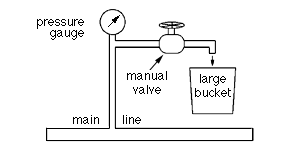Don't do this at home!
Some people recommend performing a flow test using your hose bib. Since you will not ordinarily feed a sprinkler system off of your hose bib, this test is useless! In addition, when the hose bib is opened, it is discharging against no back pressure, so the flow rate measured will not apply to a situation where sprinklers are used, since sprinklers must have adequate pressure to operate. The hose bib is useful for little more than obtaining a static pressure reading (i.e. with no water flowing.)
How to flow check your supply:
A flow check should be performed by installing the main line hook-up, cut-off valve, backflow preventer and master valve with a pressure gauge and manual valve added at the end as shown in the figure below. You can then measure the flow into a large bucket under a particular back pressure setting. Higher back pressures will result in lower flow rates. You will need to adjust the manual valve to simulate the back pressure required to operate the sprinklers. Including the pressure drop through valves and station pipes (usually 5 to 10 psi on one acre yards or less) this is typically around 40 to 50 psi total for spray sprinklers, and 60 to 70 psi total for rotors. After adjusting the manual valve to create the back pressure on the pressure gauge that's required to operate your sprinklers (40 to 50 psi total for spray heads, 60 to 70 psi for rotors), count the number of seconds it takes to fill a 5 gallon bucket. Calculate the flow rate your system can deliver using this equation:
gpm = (bucket size in gallons) times (60) divided by (seconds to fill bucket)
Flow check apparatus...

Flow check example calculation...
For example, if you can fill a 5 gallon bucket in 22 seconds with a back pressure of 70 psi your system can provide enough water to operate either rotor or spray stations requiring 13.6 gpm or less. (5 x 60 / 22 = 13.6) Often you will find that you can deliver far more flow than required, even as much as 20 to 25 gpm. Don't think for a minute, though, that you should take advantage of that much water unless your water supplier agrees that your meter is rated for that much flow, and you size up all pipe diameters downstream to handle it. Remember, high pressure or flow rate is an invitation to water hammer problems, and if you have high pressure and you drop the pressure mainly by friction losses in the pipe, you WILL have water hammer, and your system could easily fail even though the static AND steady state operating pressure are within pipe ratings! Ignore this advice and you will be stuck with a reliability nightmare. Joints will pop and valves may fail, and an extraordinary amount of effort will be required to fix it properly since much of the pipe will have to be replaced with larger diameters!
Links to continue to the next page are found at the bottom of this page.
| If you've benefited from the help we've provided on our site but you choose not to purchase your parts from us, we hope you will consider making a small donation to help offset the cost of maintaining this site. To make a donation, you can click on a button below and follow the on-screen instructions. |
|
|
|
|
Thanks!
The staff at WaterTips.com |
|








